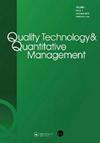Multivariate control charts for monitoring process mean vector of individual observations under regularized covariance estimation
IF 3
2区 工程技术
Q3 ENGINEERING, INDUSTRIAL
Quality Technology and Quantitative Management
Pub Date : 2021-11-28
DOI:10.1080/16843703.2021.1948952
引用次数: 1
Abstract
ABSTRACT Multivariate control charts are generally used in industries for monitoring and diagnosing processes characterized by several process variables. The applications of charts assume that the in-control process parameters are known and the charts’ limits are obtained from the known parameters. The parameters are typically unknown in practice, and the charts’ limits are usually based on estimated parameters from some historical in-control datasets in the Phase I study. The performance of the charts for monitoring future observation depends on efficient estimates of the process parameters from the historical in-control process. When only a few historical observations are available, the performance of the charts based on the empirical estimates of the process mean vector and covariance matrix have been shown to deviate from the desired performance of the charts based on the true parameters. We investigate the performance of the multivariate Shewhart control charts based on several shrinkage estimates of the covariance matrix when only a few in-control observations are available to estimate the parameters. Simulation results show that the control charts based on the shrinkage estimators outperform the charts based on existing classical estimators. An example involving high-dimensional monitoring is provided to illustrate the performance of the proposed Shrinkage-based Shewhart chart.基于正则化协方差估计的多变量控制图监测过程均值向量
多变量控制图通常在工业中用于监测和诊断具有多个过程变量特征的过程。图的应用假设控制过程参数是已知的,图的极限是由已知的参数得到的。在实践中,这些参数通常是未知的,图表的限制通常是基于第一阶段研究中一些历史控制数据集的估计参数。用于监测未来观测的图表的性能取决于对历史控制过程的过程参数的有效估计。当只有少量的历史观测时,基于过程平均向量和协方差矩阵的经验估计的图表的性能已被证明偏离基于真实参数的图表的期望性能。我们研究了基于协方差矩阵的几个收缩估计的多元Shewhart控制图的性能,当只有少数控制观测值可用来估计参数。仿真结果表明,基于收缩估计的控制图优于基于现有经典估计的控制图。提供了一个涉及高维监测的例子来说明所提出的基于收缩的Shewhart图的性能。
本文章由计算机程序翻译,如有差异,请以英文原文为准。
求助全文
约1分钟内获得全文
求助全文
来源期刊

Quality Technology and Quantitative Management
ENGINEERING, INDUSTRIAL-OPERATIONS RESEARCH & MANAGEMENT SCIENCE
CiteScore
5.10
自引率
21.40%
发文量
47
审稿时长
>12 weeks
期刊介绍:
Quality Technology and Quantitative Management is an international refereed journal publishing original work in quality, reliability, queuing service systems, applied statistics (including methodology, data analysis, simulation), and their applications in business and industrial management. The journal publishes both theoretical and applied research articles using statistical methods or presenting new results, which solve or have the potential to solve real-world management problems.
 求助内容:
求助内容: 应助结果提醒方式:
应助结果提醒方式:


